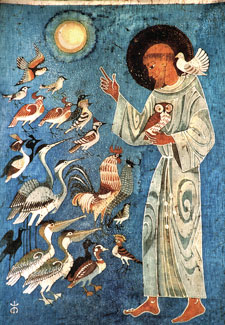From Paleolithic to Present, Art Unlocks the Divine

The theory that people have different learning styles is widely accepted today. The Church has developed ways of worship that appeal to all these styles: musical intelligence is served by songs we sing; interpersonal Christians thrive on community; logical-mathematical types enjoy the cycles of the Order of the Mass and the Liturgical year; and, of course, the visual-spatial intelligence is served by our rich tradition of fine art.
We all look for God in our lives, and in our personal journeys we find him differently. Some find him in a brilliant piece of computer programming; others in the faces of children, in nature, in silence. We search for the infinite through our own narrow windows, witnessing our own unique view of creation. Visual art is a chance to look through someone else’s unique window and to experience creation, briefly, as someone else.
Indeed, making art is itself a sort of prayer. Sometimes saying thank you to God feels inadequate, so we reach out and grab the physical world—mud, plants, horsehair—and try to form it into a vision of transcendence. The desire to make art is a manifestation of our longing for God.
In August of 2011, Pope Benedict, addressing an audience at Castel Gandalfo, said
“A work of art is a product of the creative capacity of the human being who in questioning visible reality, seeks to discover its deep meaning and to communicate it through the language of forms, colour, and sound. Art is able to manifest and make visible the human need to surpass the visible, it expresses the thirst and the quest for the infinite.”
In her comprehensive book The Case for God, Karen Armstrong starts not with the early Church or even with the pre-Christian gods of the Egyptians and the Greeks. Instead, she begins with art that is five times older than even the pyramids: the cave paintings of Lascaux.

Paleolithic humans created the first known art, and some of it—the “mobiliary” art—was the leisurely sketches one would expect, something created while resting. However, the best known paleolithic art are the “parietal” artworks: massive ceiling and wall paintings, terrifying and incredible spectacles accessed only by climbing into treacherous and dark, narrow chutes. It’s hard to imagine a Paleolithic human, concerned every day for basic subsistence and warmth, would risk his or her life in such conditions to create art. This art is thought to have been religious in nature, a groping for understanding what is beyond the hills and bison and birds.
For Paleolithic humans, art was an important and practical skill, as important as hunting and cooking, warmth and family. It was a way to pursue the divine, and their religion was as precious to them and as crucial to survival as everything else they did. That is, one hopes, still true today of our relationship to our faith.
Karen Armstrong writes, “Religion is hard work. Its insights are not self-evident and have to be cultivated in the same way an appreciation of art, music, or poetry must be developed. Religion was not something tacked on to the human condition...The desire to cultivate a sense of the transcendent may be the defining human characteristic.”
The art of our faith, and even the art outside our faith, needs to be fully engaged to unlock the divine power and inspiration within it. The art of our churches and liturgy, the art of our religious education textbooks, is not mere decoration, but an expression of our desire to find God in all things, to participate in God’s ongoing creation by creating new windows through which to see him.
